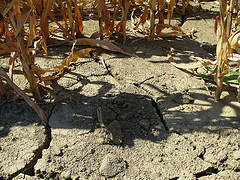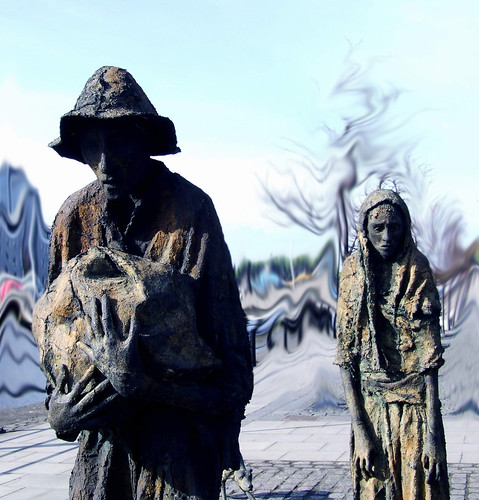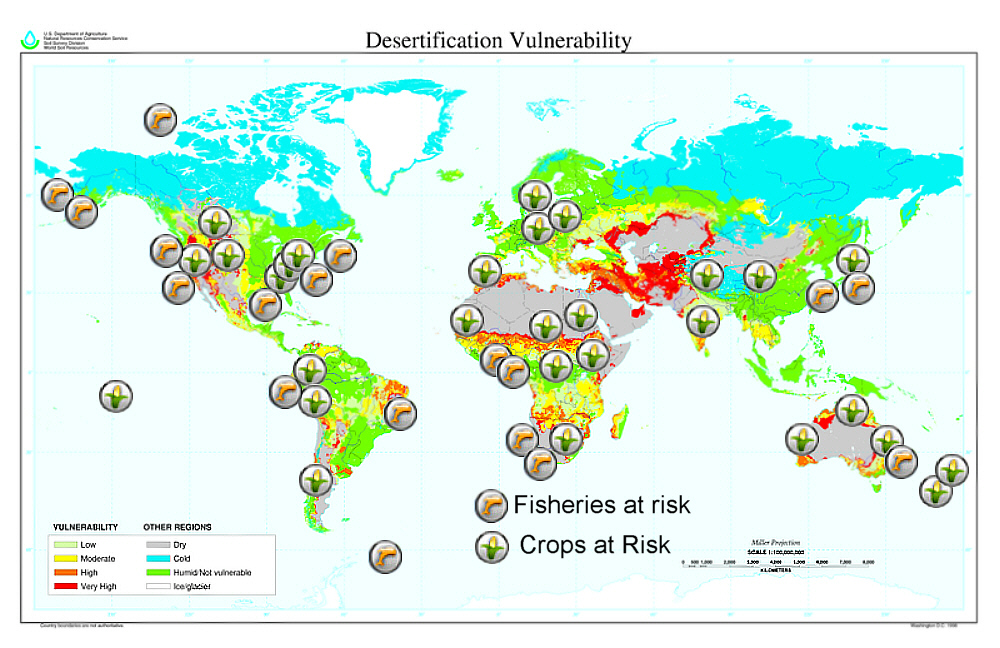Climate Change: The Question Of Bread

NEWS JUNKIE POST
Aug 30, 2010 at 8:43 amI despair when I hear people talk about climate change in terms of failing ski resorts and longer growing seasons. The disconnect between the common perception of what climate change really is and what people think it means is truly terrifying.
One of the unfortunate things about Al Gore’s “Inconvenient Truth” is it led to the notion that the principle threat posed by climate change is coastal flooding. One could watch the film and conclude that if you didn’t live near a coast climate change is problem that need not concern you directly – NOT!
About a year ago articles like “Billions could go hungry from global warming by 2100 started appearing and this seemed to surprise a lot of people. Reality check. Far and away the most serious threat posed by climate change is famine; truly massive, global famine.
This seems counter-intuitive as another unfortunate climate change myth is that it will be good for plants. More warmth and higher CO2 levels sure sounds like it should. The threat to crops is is in various ways and not all regions are threatened. In fact under conditions of moderate climate change a few regions of the world will actually benefit in the short to medium term. (Note “short to medium term” = decades, not centuries)
However they are the exception. For the majority the effects will range from negative to devastating. Indeed Australia, northeast Africa, and the western United States are already visibly suffering the consequences.
Climate change affects crops in different ways because they are complex systems. Yes there is more CO2 and it will get warmer, but “warmer” leads to quite a few different consequences depending on other factors. I would like to offer a quick survey to help people appreciate what we are facing.
Let’s start with rising seas. A two meter rise in sea level may not seem like much if you are thinking of the cliffs of Dover, but for low lying places like Bangladesh and Florida it is huge. Some of the worlds best agricultural land is in river deltas like the Nile and the Mekong which are very close to sea level.
 The greater threat from rising sea levels is not actual flooding, but infiltration of ground water by sea water. Once the ground water becomes saline the salt migrates up through the soil and turns productive land into a salt desert.
The greater threat from rising sea levels is not actual flooding, but infiltration of ground water by sea water. Once the ground water becomes saline the salt migrates up through the soil and turns productive land into a salt desert.
A two meter rise in sea level can affect agricultural land quite some distance from the ocean. A majority of the world’s food production is within 5 m of sea level.
Warmer weather means different weather, and that means changes in rainfall. There are a great many variables involved in creating weather, but some broad patterns are known.
Warmer air can hold more moisture, which will mean more rainfall in some regions when the air masses bring in more moisture. In other regions it will mean greater drought as the warmer air sucks up more moisture. It depends on how saturated with moisture the air is, and on whether the system is warming or cooling. Systems that are cooling will tend to drop rain. Systems that are warming will tend to suck up moisture.
Weather systems coming off of the ocean will tend to be wet. Systems coming from mountains will tend to be drying as the air descends and warms. The same will tend to be true for systems moving from north to south (ie they will be warming).
In crude terms we expect dry areas to get drier, and wet areas to get wetter. Neither is good news.
Most grain growing regions in the world are really pretty dry,  including the Canadian prairies, the American West, the Ukraine and northern China. Marginal lands will become desert and good land degraded. Already areas of Oklahoma and Texas are experiencing drought comparable to what they experienced in the Great Dust Bowl of the 1930s.
including the Canadian prairies, the American West, the Ukraine and northern China. Marginal lands will become desert and good land degraded. Already areas of Oklahoma and Texas are experiencing drought comparable to what they experienced in the Great Dust Bowl of the 1930s.
Yes the IPCC stated that for North America “In the early decades of the century, moderate climate change is projected to increase aggregate yields …”, but the rest of that quote is “… of rain-fed agriculture by 5 to 20%, but with important variability among regions. “
In other words food production that depends on irrigation and/or is already in a water stressed region will not benefit; in these regions food production will decline.
So what areas of North America have been experiencing more drought in the past decade or so? The West of course (Canada and USA), California, the South East, and Florida; ie almost everywhere that grows the majority of North American food.
 But more rain is not a good thing either as flooding will kill a crop as effectively as drought, as happened in the American mid-west and is happening in Pakistan.
But more rain is not a good thing either as flooding will kill a crop as effectively as drought, as happened in the American mid-west and is happening in Pakistan.
Even without floods more water can be a problem as low lying areas become flooded or marshy, and poorer draining soils become waterlogged, all of which damages crops or removes land from production entirely.
Any farmer can tell you that it’s not just how much rain they get, it’s when it comes. For regions that experience changes in rainfall it is critical how and when the rain comes.
It seems likely that the increases we expect will not be spread out, but rather come as stronger, more intense storms. These will damage crops directly without necessarily benefiting them as the water simply runs off. Increased runoff will cause more soil erosion and flood waterways.
Even if the total rainfall is “just right”, it won’t matter if it doesn’t  come at the right times. Drenching storms followed long dry periods are of no particular benefit.
come at the right times. Drenching storms followed long dry periods are of no particular benefit.
Lack of rain during planting will not be fixed by heavy rain later. Too much rain during harvest season can destroy a crop completely. Wetter will also mean increased mold, rot, and other diseases for many crops.
Warmer weather also means more intense heat waves, and more of them. Heat waves stress crops and reduce productivity at the best of times. If there is an intense heat wave during germination, flower set, or fruit set it can wipe the crop out completely.
The worlds glaciers are in catastrophic decline and this is disaster for agriculture in many parts of the world. Historically in winter the glaciers act as a storehouse for accumulated snow which then melts in high summer.
Source: World Glacier Monitoring Service
Many regions of the world depend on glacier fed rivers for irrigation during the driest part of the summer. This is true of the Canadian prairies, large areas of the American West, temperate South America, and much of central Asia. At current rates of decline glaciers will cease to be a meaningful source of water sometime in the next 30 to 40 years.
Climate change not only threatens crops, but fisheries as well. The increased acidification of ocean caused by CO2 absorption impacts marine life in many ways, and for the most part not good. As things currently stand we anticipate almost all fisheries to be wiped out within decades under the dual pressure of climate change and over fishing.
Regardless of the morality of it, the fact is that at least some of the worlds cropland is dedicated to biofuels and that will probably increase as the price of oil increases. Farmers will sell where they get the best price, and if the wealthy are willing to pay more to continue to indulge their luxuries, then the poor will be without food just as they are now.
The Global Outlook
Large areas of the worlds most productive regions are expected to suffer reduced yields from climate change. Indeed for most years in the past decade the world has consumed more grain than it produced and world grain reserves are now near record lows.
Many countries already ban or limit food exports and that is going to increase. At the same time many western countries are encouraging the production of biofuels for economic reasons, but that is taking the land out of food production.
Looking at the above map ask yourself “In 30 years where will my food come from? and how much will it cost?”
Needless to say this is still a very simplistic overview of a complex issue. Many posts could be written on the physiology of plant responses to heat stress, or pests and diseases on crops, never mind the uncertainties of predicting regional climate.
Even so I hope it has helped to banish the notion that climate change will have some positive benefits, at least if you agree that famine and accompanying civic collapse tends to over-shadow things like “more beach days.”
There is a certain irony that diet, which is the largest portion of our carbon footprint for most of us, is also the part of our life that is most threatened by climate change. There are numerous simplistic suggestions for dealing with the coming food crisis, but many of them are as flawed as the “more CO2 means more food” fable is.
 Of the coming food crisis New Scientist said “…3 billion people will have to choose between going hungry and moving…” Uhm, move to where? Where exactly do we currently have the room for 3 billion people?
Of the coming food crisis New Scientist said “…3 billion people will have to choose between going hungry and moving…” Uhm, move to where? Where exactly do we currently have the room for 3 billion people?
A far more likely scenario is that presented by the series “Climate Wars” (Ideas1 Ideas2 Ideas3) and highly recommended.
“The question of bread for myself is a material question, but the question of bread for my neighbor is a spiritual question.”
Nikolai Bordyaev
Image Credits:
Flight from famine…. by tezzer57
Desertificazione, desertification, desertifikation by pizzodisevo (sorry, the left hand hurts)
Happy Halloween From Sunny New Jersey! by Sister72
Drought Along Po River by brtsergio
Custom House Famine Memorial by infomatique
Related Articles
- September 14, 2010 Sacred Rites Or Selfish Rights
- January 3, 2015 Sustainable Ways to Feed the World Are Subverted by Corporations
- May 31, 2011 Oxfam Report: ‘The Global Food System Is Broken’
- March 8, 2010 Democracy Now! For Ecological Sustainability
- March 7, 2011 Overpopulation, Climate Change, Food Crisis, War: The Horsemen Of Apocalyptic Capitalism
- January 24, 2011 Tunisia, WikiLeaks And Food Crisis: Forces For A Global Revolution















2 Responses to Climate Change: The Question Of Bread
You must be logged in to post a comment Login